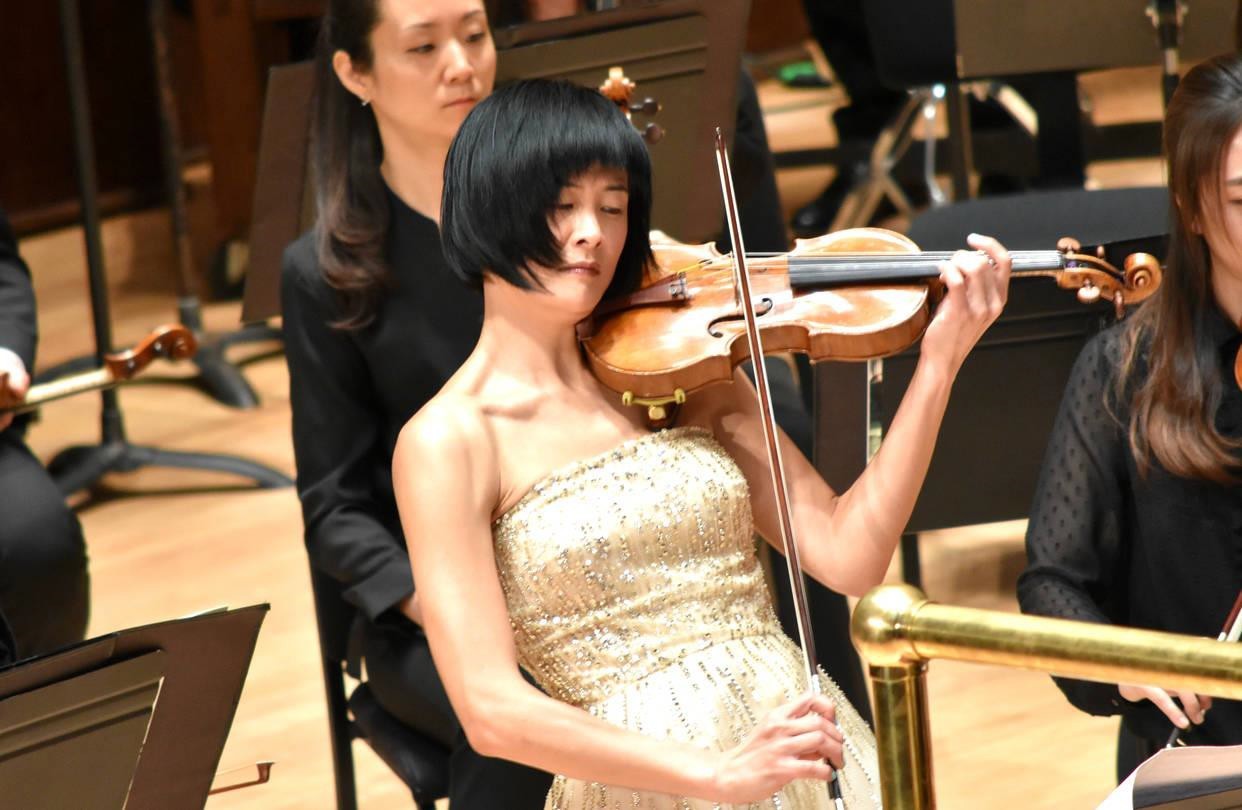By David Mermelstein
The Wall Street Journal
May 31, 2018
original
link
New-Music Premieres in Detroit
Even with its departing music director, Leonard Slatkin, absent, the Detroit Symphony Orchestra (with Peter Oundjian stepping in) offered spirited performances of Roshanne Etezady’s ‘Diamond Rain’ and Christopher Cerrone’s ‘Breaks and Breaks.’

Jennifer Koh performing with the Detroit Symphony Orchestra
PHOTO: BEN BREUNINGER/DETROIT SYMPHONY ORCHESTRA
Detroit
Like the city it has served nearly continuously since 1887, the Detroit Symphony Orchestra has seen good times and bum times and is still here, my dear. Leonard Slatkin has been its music director for the past decade, and he had planned to conclude this season—his last before transitioning to laureate status—with three varied programs, mixing music old and new, intimate and grand. But even as the conductor’s metaphorical heart was committed to the enterprise, his actual heart was not. Earlier this month, Mr. Slatkin, age 73, underwent bypass surgery, and his recovery precluded conducting anytime soon. (We’re told he’s healing well.)
Though there was no question of canceling these subscription concerts, it wasn’t initially clear who would step in for the ailing maestro and whether the programs would remain unchanged. But three willing replacements were found, and Mr. Slatkin’s carefully plotted farewell is proceeding as
planned, albeit without him on the podium. The first of the programs, with three performances from May 25 through 27, proved the trickiest, for it featured two premieres, one with soloist. But in securing Peter Oundjian —who in June departs as music director of the Toronto Symphony after 14 seasons—the orchestra reunited with an old friend; Mr. Oundjian was the Detroit Symphony’s principal guest conductor from 2006 through 2010.
Mr. Slatkin has long been an advocate of American music—not just in Detroit but also while leading orchestras in Washington and St. Louis, before his tenure here. That commitment includes music by living composers, even some still rising to prominence. And this first program opened with two premieres by just such composers—a short tone poem by Roshanne Etezady and a violin concerto by Christopher Cerrone —before giving way, after intermission, to a perennial favorite: Tchaikovsky’s “Pathétique” Symphony, in a refreshingly unsentimental account.
Ms. Etezady’s “Diamond Rain,” inspired by an amusing meteorological phenomenon suggesting that diamonds could fall from Neptune’s skies, emerged as a showpiece of vivid orchestral colors, allowing the players to demonstrate their technical prowess within appealing, occasionally unexpected sonorities. Tropes associated with sci-fi movie scores—brass fanfares, arpeggiated strings and the like—dominated, and the composer later tipped her hat toward Philip Glass and John Adams. But fresher gestures—a cabasa rattling, sandpaper blocks scraping, and some Middle Eastern flavors—along with a lovely, pensive conclusion, courtesy of the woodwinds, conveyed a distinct personality.
The 34-year-old Mr. Cerrone is among that select group of young composers whose work is known beyond arcane musical circles. His opera “Invisible Cities,” based on Italo Calvino’s short novel of the same name and a Pulitzer Prize finalist, was something of a cultural happening when it received its premiere in 2013. Audiences heard it via headphones while roaming the corridors of Los Angeles’s bustling Union Station, where its scenes unfolded amid unwitting travelers.
Literary sources figure prominently in Mr. Cerrone’s oeuvre, which thus far consists primarily of chamber and solo pieces. So it is with his new Violin Concerto, which carries the title “Breaks and Breaks,” words taken from the final stanza of Stanley Kunitz’s poem “The Testing-Tree.” Ironically, the concerto itself contains no pauses, or breaks, within its seven movements. The piece, whose varied imagery was also influenced by several non-Kunitz texts, was written for the Chicago-born violinist Jennifer Koh, a musician of immaculate control, keen intelligence and a slightly cool demeanor, for whom the composer had previously written a short solo work.
The combination of score and soloist could hardly have been better matched. The piece opens with the solo violin calmly ascendant against muted strings, the ambience quickly punctured by disconcerting whispers from the flutes. A range of moods and modes then enter and recede, with the solo line shifting from dizzyingly intense to plaintively soulful and back again. Though attention is mostly focused on the soloist, other voices occasionally spike the mix, including a haunted- sounding piano that augurs darkly against a drumbeat. The short opening melody recurs several times in different guises, but never more movingly than when echoed by massed strings in a gesture of musical community. After rapid figures from the soloist hearken to Bach and an aural fog subsumes them, sharp cries from the violin suggest an impending conclusion, but the end is postponed until after the soloist recedes and a gentle corona of plinking percussion fades out.
If Mr. Slatkin watched the webcast, he should have been proud, for the orchestra performed these new scores with enviable conviction and confidence. And Mr. Oundjian led them with a mastery suggesting he’d commissioned them himself. Detroit’s claims to a classical-music tradition are real and longstanding—a host of celebrated maestros have toiled here during the orchestra’s 131-year history. In a few weeks, the Slatkin era will be over, but not this conductor’s influence, which will surely be felt for years to come, even as the city continues its steady climb from a near-ruined metropolis to one buzzing with energy and expectations.
The Wall Street Journal – Circulation: 1,180,460 (Print), 43,634,142 (Online, per month
© 2018 The Wall Street Journal
© Jennifer Koh, All Rights Reserved. Photography by Juergen Frank. Site by ycArt design studio